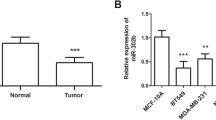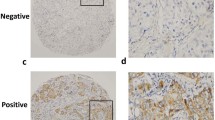Abstract
Let-7 microRNAs (miRNAs) are found in a wide range of species, and alterations of let-7 miRNA family member expression levels in humans are associated with various types of cancer. However, few researchers have reported alterations in let-7b levels in breast cancer (BC). Specifically, the use of altered let-7 expression as a prognostic biomarker is of particular interest and significance. The aim of this study was to investigate whether let-7b could be used as a biomarker of tumor progression and patient prognosis in BC and to determine the target gene of let-7b. We retrospectively analyzed the clinical pathological characteristics of 80 BC. We utilized digoxigenin-labeled locked nucleic acid-miRNA probes to detect let-7b expression in 80 BC and 22 benign breast disease (BBD) histologic specimens by in situ hybridization, and also detect the expression of BSG—a potential target gene of let-7b—by immunohistochemistry. We observed that the levels of let-7b expression in BBD were higher than in BC specimens (P < 0.05), indicating that let-7b could inhibit growth and facilitate differentiation of BBD. Also, loss of let-7b expression on BC tissue specimens raised the possibility that let-7b could play a crucial role in the pathogenesis of BC. Furthermore, let-7b expression in breast cancer patients was inversely associated with tumor lymph node metastasis (P = 0.001), patient overall survival (P = 0.027), relapse-free survival (P = 0.016), and BSG protein expression (P = 0.001). Breast cancer patients with low let-7b expression had poor prognoses, indicating let-7b might act as cancer suppressor gene in BC development and progression by inhibiting the expression of BSG.



Similar content being viewed by others
References
Bachour T, Bennett K. The role of microRNAs in breast cancer. J Assoc Genet Technol. 2011;37:21–8.
Tavazoie SF, Alarcón C, Oskarsson T, Padua D, Wang Q, Bos PD, Gerald WL, Massagué J. Endogenous human microRNAs that suppress breast cancer metastasis. Nature. 2008;451:147–52.
Yu F, Yao H, Zhu P, Zhang X, Pan Q, Gong C, Huang Y, Hu X, Su F, Lieberman J, Song E. let-7 regulates self renewal and tumorigenicity of breast cancer cells. Cell. 2007;131:1109–23.
Farazi TA, Horlings HM, Ten Hoeve JJ, Mihailovic A, Halfwerk H, Morozov P, Brown M, Hafner M, Reyal F, van Kouwenhove M, Kreike B, Sie D, Hovestadt V, Wessels LF, van de Vijver MJ, Tuschl T. MicroRNA sequence and expression analysis in breast tumors by deep sequencing. Cancer Res. 2011;71:4443–53.
Fu TY, Chang CC, Lin CT, Lai CH, Peng SY, Ko YJ, Tang PC. Let-7b-mediated suppression of basigin expression and metastasis in mouse melanoma cells. Exp Cell Res. 2011;317:445–51.
Zucker S, Hymowitz M, Rollo EE, Mann R, Conner CE, Cao J, Foda HD, Tompkins DC, Toole BP. Tumorigenic potential of extracellular matrix metalloproteinase inducer. Am J Pathol. 2001;158:1921–8.
Rucci N, Millimaggi D, Mari M, Del Fattore A, Bologna M, Teti A, Angelucci A, Dolo V. Receptor activator of NF-kappaB ligand enhances breast cancer-induced osteolytic lesions through upregulation of extracellular matrix metalloproteinase inducer/CD147. Cancer Res. 2010;70:6150–60.
Wu ZS, Wu Q, Wang CQ, Wang XN, Huang J, Zhao JJ, Mao SS, Zhang GH, Xu XC, Zhang N. miR-340 inhibition of breast cancer cell migration and invasion through targeting of oncoprotein c-Met. Cancer. 2011;117:2842–52.
Reinhart BJ, Slack FJ, Basson M, Pasquinelli AE, Bettinger JC, Rougvie AE, Horvitz HR, Ruvkun G. The 21-nucleotide let-7 RNA regulates developmental timing in Caenorhabditis elegans. Nature. 2000;403:901–6.
Lee YS, Kim HK, Chung S, Kim KS, Dutta A. Depletion of human micro-RNA miR-125b reveals that it is critical for the proliferation of differentiated cells but not for the down-regulation of putative targets during differentiation. J Biol Chem. 2005;280:16635–41.
Ibarra I, Erlich Y, Muthuswamy SK, Sachidanandam R, Hannon GJ. A role for microRNAs in maintenance of mouse mammary epithelial progenitor cells. Genes Dev. 2007;21:3238–43.
Legesse-Miller A, Elemento O, Pfau SJ, Forman JJ, Tavazoie S, Coller HA. let-7 Overexpression leads to an increased fraction of cells in G2/M, direct down-regulation of Cdc34, and stabilization of Wee1 kinase in primary fibroblasts. J Biol Chem. 2009;284:6605–9.
Paranjape T, Heneghan H, Lindner R, Keane FK, Hoffman A, Hollestelle A, Dorairaj J, Geyda K, Pelletier C, Nallur S, Martens JW, Hooning MJ, Kerin M, Zelterman D, Zhu Y, Tuck D, Harris L, Miller N, Slack F, Weidhaas J. A 3′-untranslated region KRAS variant and triple-negative breast cancer: a case–control and genetic analysis. Lancet Oncol. 2011;12:377–86.
Motoyama K, Inoue H, Nakamura Y, Uetake H, Sugihara K, Mori M. Clinical significance of high mobility group A2 in human gastric cancer and its relationship to let-7 microRNA family. Clin Cancer Res. 2008;14:2334–40.
Akao Y, Nakagawa Y, Naoe T. let-7 microRNA functions as a potential growth suppressor in human colon cancer cells. Biol Pharm Bull. 2006;29:903–6.
Jezierska A, Motyl T. Matrix metalloproteinase-2 involvement in breast cancer progression: a mini-review. Med Sci Monit. 2009;15:RA32–40.
Folgueras AR, Pendas AM, Sánchez LM, Lopez-Otin C. Matrix metalloproteinases in cancer: from new functions to improved inhibition strategies. Int J Dev Biol. 2004;48:411–24.
Bartsch JE, Staren ED, Appert HE. Matrix metalloproteinase expression in breast cancer. J Surg Res. 2003;110:383–92.
Acknowledgments
This work was supported in part by a grant from Higher school of Anhui Provincial Natural Science Research Project, China (#KJ2013Z206).
Conflict of interest
The authors have no conflict of interest.
Author information
Authors and Affiliations
Corresponding author
Rights and permissions
About this article
Cite this article
Ma, L., Li, Gz., Wu, Zs. et al. Prognostic significance of let-7b expression in breast cancer and correlation to its target gene of BSG expression. Med Oncol 31, 773 (2014). https://doi.org/10.1007/s12032-013-0773-7
Received:
Accepted:
Published:
DOI: https://doi.org/10.1007/s12032-013-0773-7




